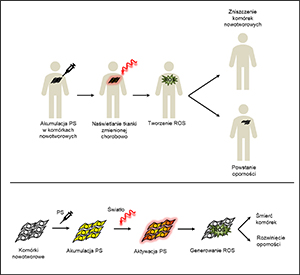Photodynamic therapy – significance in oncology
DOI:
https://doi.org/10.18388/pb.2021_394Abstract
Photodynamic therapy (PDT) is one of the least toxic methods causing the death of cancer cells. Photosensitizer (PS) applied to a patient accumulates in the tumor, where under the appropriate wavelength and insensitivity of light is activated. Activated PS in the presence of oxygen produces reactive oxygen species (ROS), which make significant damage leading to the destruction of cancer cells by apoptosis, necrosis or autophagic process. Moreover, PDT causes an acute local inflammatory response that is involved in removing dead cells, restoring normal tissue homeostasis, and sometimes leads to the development of systemic immunity. However, some cells may survive treatment and develop resistance. Mechanisms, which lead to decrease of the level of PS in cells may be involved in the cytoprotection of cancer cells from PDT. Furthermore, increased activity of antioxidant mechanisms, overexpression of molecular chaperones and activation of survival pathways can protect cells from PDT.

Published
Issue
Section
License
Copyright (c) 2021 Advances in Biochemistry

This work is licensed under a Creative Commons Attribution 4.0 International License.
All journal contents are distributed under the Creative Commons Attribution-ShareAlike 4.0 International (CC BY-SA 4.0) license. Everybody may use the content following terms: Attribution — You must give appropriate credit, provide a link to the license, and indicate if changes were made, ShareAlike — If you remix, transform, or build upon the material, you must distribute your contributions under the same license as the original. There are no additional restrictions — You may not apply legal terms or technological measures that legally restrict others from doing anything the license permits.
Copyright for all published papers © stays with the authors.
Copyright for the journal: © Polish Biochemical Society.



